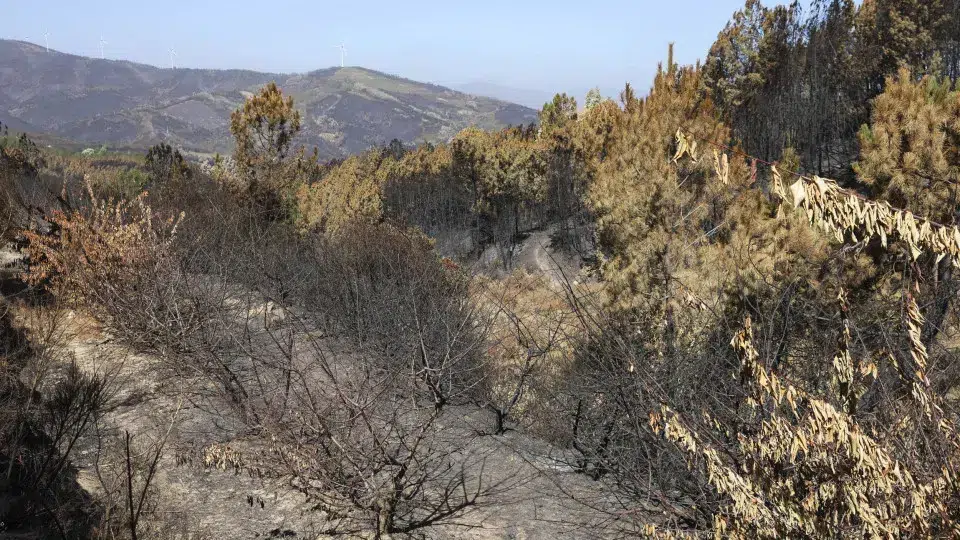
In Enxabarda, a small village with about 200 residents located in the Serra da Gardunha, stories among producers repeat themselves. Twenty to 25 years ago, many left their original jobs for agricultural projects, particularly cherry farming, transforming wild hills into thriving orchards.
Following a fire that began in Arganil and rapidly moved across the Serra de Lavacolhos, encircling the village, tales of losses are recounted and the burnt hectares of cherry orchards are calculated.
In the local café, conversations either revolve around the fire or fall into silence, says Sara Martins, 42, who has been cultivating orchards since 2013, following her mother’s path, who swapped factory work for cherry farming, a hallmark of the region.
At times, Sara confesses she is unsure whether she prefers the silence or the repetitive stories and grievances about the fire.
Sara, her mother Maria José, her husband, and her father cultivate about 50 hectares of orchards around Enxabarda. Roughly seven to eight hectares burned, while another eight are just two years old and not yet productive: “They are the younger ones,” she remarks.
After two setbacks this year and in 2024 with hail and frost impacting a significant part of the harvest, the fire forces producers to reconsider investments, explains Sara.
The agronomy-trained farmer drives a jeep along a dirt road lined with burned pine trees, brush, and scorched orchards. However, some green orchards stand resilient without a drop of water touching them as flames swept through.
Observing the fire’s progress across the region and the resilience some orchards display, Sara critiques the lack of planning and organization, suggesting that tractors should not only be employed during the frantic hours of a fire but months ahead, crafting paths and firebreaks systematically.
“These are cherry trees,” Sara points to blackened trees, corrected immediately by her mother, who fights back tears: “They were.”
After studying in the Algarve and spending six to seven years away from Enxabarda, Sara returned home in 2013, starting cherry cultivation, and began harvesting a few years later.
Besides the burned trees, she warns that some cherry trees, even unburned, might not bear fruit next year.
Maria José shows floral buds that have dried out: “These were next year’s cherries. They are all burned.”
In addition to the dried buds, stress and heat could lead to significant fruit drop next year.
The rising threat of pests and the loss of pollinators are further risks, Sara notes, fearing a weaker coming harvest from what survived.
After the fire skirted the village on August 19, Sara quickly ascended the mountain the following morning to assess what was spared. With tractors and sprayers, they made efforts to combat flames and rekindle.
For Sara, on that morning after the fire’s passage, the priority was determining if what remained would allow them to continue.
“That first night, I thought I couldn’t go on. But yes, we can. We can go on,” she asserts.
Patrique Martins, 46, has not yet had the strength to address the paperwork he received for assessing the losses: “I’m just not motivated to do it.”
For 20 years, he bet on cherries, and when the fire struck, his focus was saving the warehouse amidst the “fast” fire that turned day into night.
Nevertheless, he considers himself among the “more fortunate.” He lost three out of his 40 hectares of orchards.
Gabriel Martins, 58, lost 40% of his blueberry production and four to five hectares out of his total 15 hectares of cherry orchards, which were once bush land before he transitioned from being an electrician to agriculture.
“I look to the future with great apprehension,” he says, unsure of how to proceed with trees that might not recover.
“It will be six tough years” until the new trees bear fruit, he notes, feeling “helpless,” as even the pine forest, which cushioned poorer campaigns, was entirely destroyed by the fire.
José Pereira, 57, expresses no desire to restart after losing over half of his orchards.
“I have a 15-year-old son and an 18-year-old daughter who just started university. I don’t know what will happen, but I will have to do something,” he insists.
Luís Ribeiro, who turned to cherry farming 15 years ago, states that it was cherries “that brought life to Enxabarda.”
“Until about 20 years ago, there wasn’t much cultivation. Before, people here either lived off small agriculture or emigrated,” he says, believing Enxabarda now needs a “push” to recover from this setback.
“We need to let the ashes settle and assess whether recovery and working from these ashes is worthwhile,” Sara explains.
Her mother is still trying to process the loss after “much work, much time,” converting bush into orchards.
In the days that followed, like her daughter, Maria José endeavored to combat every flare-up and flame she encountered. “It was about defending the heart,” she said.




